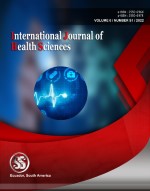Isolation and identification of Aspergillus fumigatus from feline respiratory infection in Baghdad province
Keywords:
Aspirgillus fumigatus, fungal infection, feline respiratory infectionAbstract
Aspergillus fumigatus considered to be the most important species to cause respiratory infection cases in both humans and animals especially in cats in the last decades. In this study, we focused on the isolation and identification of Aspergillus fumigates by collecting 40 samples in deferent veterinary clinics and stray cats in Baghdad city, during the period (October 2021 to January 2022), all samples were cultured on Sabouraud dextrose agar and malt extract agar. The isolates identified by the laboratory methods, it’s depend on macroscopic and microscopic appearance. The results showed that (40) swaps taken from the pharynx of infected cats, included: Aspergillus fumigatus 16 (40%), Aspergillus spp. 7 (17.5%), Aspergillus niger 8 (20%), Penicillium spp. 5 (12.5%), Cryptococcus spp. 3 (7.5%), Fusarium spp. 1 (2.5%), and the presence of infection in female (62.5%) more than male (37.5%), this study indicated that the virulence and normal habitat of Aspergillus fumigatus make it the most important pathogen to cause respiratory infection and allergen in cats.
Downloads
References
Seyedmousavi, S., Guillot, J., Arné, P., De Hoog, G. S., Mouton, J. W., Melchers, W. J., & Verweij, P. E. (2015). Aspergillus and aspergilloses in wild and domestic animals: a global health concern with parallels to human disease. Medical mycology, 53(8), 765-797.
Garnacho-Montero, J., Amaya-Villar, R., Ortiz-Leyba, C., León, C., Álvarez-Lerma, F., Nolla-Salas, J., ... & Barcenilla, F. (2005). Isolation of Aspergillus spp. from the respiratory tract in critically ill patients: risk factors, clinical presentation and outcome. Critical Care, 9(3), 1-9.
Bennett, J. W. (2009). Aspergillus: a primer for the novice. Medical mycology, 47(sup1), S5-S12.
May, G. S., Goldman, G. H., & Osmani, S. A. (2008). Mitogen-activated protein kinase pathways in Aspergilli. The Aspergilli. Genomics, medical aspects, biotechnology, and research methods, 121-127.
Van De Veerdonk, F. L., Gresnigt, M. S., Romani, L., Netea, M. G., & Latge, J. P. (2017). Aspergillus fumigatus morphology and dynamic host interactions. Nature Reviews Microbiology, 15(11), 661-674.
Latgé, J. P. (1999). Aspergillus fumigatus and aspergillosis. Clinical microbiology reviews, 12(2), 310-350.
Barrs, V. R., & Talbot, J. J. (2014). Feline aspergillosis. Veterinary Clinics: Small Animal Practice, 44(1), 51-73.
Samanta, I. (2015). Veterinary mycology. Springer India.
Gharban, H.A.J., and Al-Shaeli, S.J.J. (2021). Clinical and serum biochemical evaluation of goats with hypomagnesemia. Biochem. Cell. Arch., 21 (1), 587-592.
Hartmann, K., Lloret, A., Pennisi, M. G., Ferrer, L., Addie, D., Belák, S., ... & Horzinek, M. C. (2013). Aspergillosis in cats: ABCD guidelines on prevention and management. Journal of feline medicine and surgery, 15(7), 605-610.
Soltys, M. A., & Sumner-Smith, G. (1971). Systemic mycoses in dogs and cats. The Canadian Veterinary Journal, 12(10), 191.
Al-Kaisie, B. I. (2005). Study of important moulds isolated from milk and its products in Baghdad – with experimental study the pathogenesis of Aspergillus Fumigatus moulds in mice: Bushra.I.Al-Kaisie , Jinan Khalid. The Iraqi Journal of Veterinary Medicine, 29(2), 67–80.
Sugahara, G., Kiuchi, A., Usui, R., Usui, R., Mineshige, T., Kamiie, J., & Shirota, K. (2014). Granulomatous pododermatitis in the digits caused by Fusarium proliferatum in a cat. Journal of Veterinary Medical Science, 76(3), 435-438.
Cafarchia, C., Romito, D., Sasanelli, M., Lia, R., Capelli, G., & Otranto, D. (2004). The epidemiology of canine and feline dermatophytoses in southern Italy. Mycoses, 47(11‐12), 508-513.
Suryasa, I. W., Rodríguez-Gámez, M., & Koldoris, T. (2021). The COVID-19 pandemic. International Journal of Health Sciences, 5(2), vi-ix. https://doi.org/10.53730/ijhs.v5n2.2937
Suryasa, I. W., Rodríguez-Gámez, M., & Koldoris, T. (2022). Post-pandemic health and its sustainability: Educational situation. International Journal of Health Sciences, 6(1), i-v. https://doi.org/10.53730/ijhs.v6n1.5949
Published
How to Cite
Issue
Section
Copyright (c) 2022 International journal of health sciences

This work is licensed under a Creative Commons Attribution-NonCommercial-NoDerivatives 4.0 International License.
Articles published in the International Journal of Health Sciences (IJHS) are available under Creative Commons Attribution Non-Commercial No Derivatives Licence (CC BY-NC-ND 4.0). Authors retain copyright in their work and grant IJHS right of first publication under CC BY-NC-ND 4.0. Users have the right to read, download, copy, distribute, print, search, or link to the full texts of articles in this journal, and to use them for any other lawful purpose.
Articles published in IJHS can be copied, communicated and shared in their published form for non-commercial purposes provided full attribution is given to the author and the journal. Authors are able to enter into separate, additional contractual arrangements for the non-exclusive distribution of the journal's published version of the work (e.g., post it to an institutional repository or publish it in a book), with an acknowledgment of its initial publication in this journal.
This copyright notice applies to articles published in IJHS volumes 4 onwards. Please read about the copyright notices for previous volumes under Journal History.
















